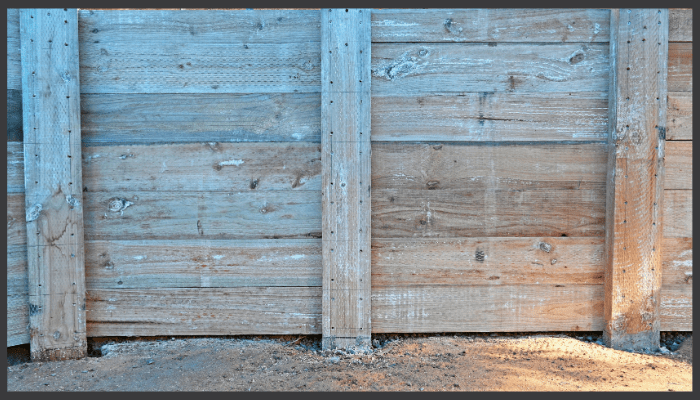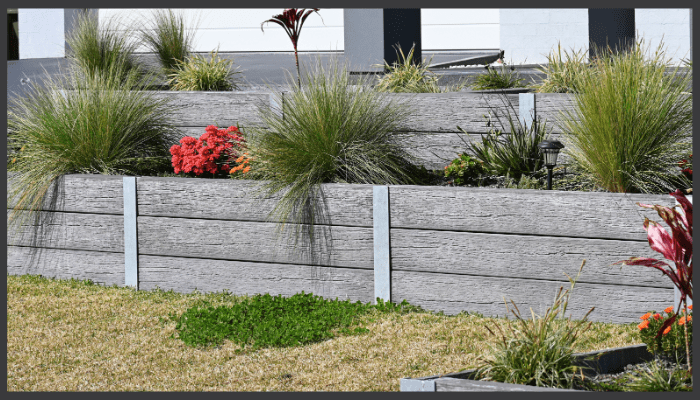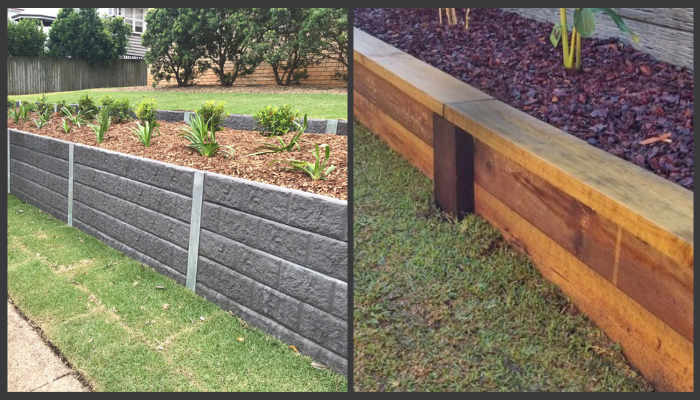Are Concrete Sleepers Or Timber Sleepers Best for Retaining Walls
Concrete Sleepers vs. Timber Sleepers: Which is Best for Your Retaining Wall?
Choosing the right material for your retaining wall is crucial to ensuring both durability and aesthetic appeal in your outdoor space. When it comes to retaining wall projects, two popular options stand out: concrete sleepers and timber sleepers.
Each has its own unique advantages and applications, and the decision will depend on your specific needs and preferences. In this guide, we’ll explore the differences between these materials to help you make an informed decision for your retaining wall project.
What Are Concrete Sleepers and Timber Sleepers?
Concrete sleepers are heavy-duty retaining wall materials known for their strength and longevity. Commonly used in construction projects and landscaping, they offer structural integrity that can withstand harsh weather conditions and heavy loads.
Available in various sizes and finishes, such as smooth concrete sleepers, woodgrain concrete sleepers, and charcoal concrete sleepers, they cater to a wide range of landscaping styles.
Concrete sleepers are a key component of modern retaining wall systems, particularly when paired with steel posts for added reinforcement.
Their durability, combined with low maintenance requirements, makes them a popular choice for retaining wall blocks and garden beds.
Timber sleepers, on the other hand, are valued for their natural look and rustic charm. Made from treated pine or hardwood, they are often used in timber retaining walls, garden edging, and small landscaping projects.
Pine sleepers, particularly treated pine sleepers, are cost-effective solutions for creating a warm and natural aesthetic.
While timber walls may require more maintenance compared to concrete, they remain a popular option for homeowners who want a visually appealing and environmentally friendly retaining wall material.
Comparing Concrete and Timber Sleepers for Retaining Walls
Concrete sleepers are built to last. Unlike timber, they are resistant to pests, rot, and harsh weather conditions, ensuring a long-term solution for retaining wall construction.
Reinforcement bars in concrete sleeper retaining walls add extra strength, making them ideal for retaining wall heights that require heavy-duty support.
Timber sleepers, while offering a natural look, are more susceptible to environmental factors such as moisture and pests. Treated timber can extend its lifespan, but it may still need regular maintenance to prevent deterioration.
One of the key advantages of concrete sleepers is their low maintenance. Once installed, they require minimal upkeep, making them a hassle-free option for busy homeowners.
Timber sleepers, however, may need periodic treatments to protect against rot and insects, particularly in challenging weather conditions.
When it comes to visual appeal, both materials offer distinct advantages. Concrete sleepers are available in a range of colours and textures, including industrial finishes and designs that mimic natural stone or woodgrain.
These options can complement a variety of landscaping projects, from modern outdoor spaces to classic garden beds.
Timber sleepers provide a more traditional and organic feel, blending seamlessly with garden edging and natural landscaping elements.
The rustic charm of hardwood sleepers and treated pine can enhance the natural beauty of your outdoor space.
Timber sleepers are generally more affordable upfront, making them a cost-effective solution for DIY enthusiasts and smaller projects.
However, when considering the long-term costs associated with maintenance and replacement, concrete sleepers may prove to be the better option for many retaining wall projects.
Best Retaining Wall Applications for Each Material
Concrete sleepers are best for concrete sleeper retaining walls, heavy-duty construction projects, and garden beds requiring maximum retaining wall height.
They feature durable materials, a range of sizes, and low maintenance, making them ideal for outdoor spaces needing long-lasting and structural solutions.
Timber sleepers are ideal for timber retaining walls, garden edging, and decorative landscaping. They offer rustic charm, a natural look, and environmentally friendly options, making them perfect for smaller projects or areas where a warm, organic aesthetic is preferred.
Key Factors to Consider Before Choosing
Concrete sleepers are suitable for retaining walls that require significant height and strength, while timber sleepers are better suited for lower wall systems or garden edging.
Consider your local weather conditions. Concrete sleepers handle extreme climates and wet conditions better, whereas timber may require additional protection in areas prone to heavy rainfall.
Both materials are relatively easy to install, but concrete sleepers can be heavier and require more effort to manoeuvre. Timber sleepers are lighter and often more manageable for DIY enthusiasts.
Ensure you source high-quality materials from trusted suppliers like Pinus Sawmills. With a wide range of sizes and finishes available, choosing the right retaining wall material has never been easier.
Other Retaining Wall Options to Consider
If neither concrete sleepers nor timber sleepers meet your specific needs, there are alternative retaining wall options available. These include gabion walls, sandstone blocks, rock walls, and concrete block retaining walls. Each of these solutions has unique features to suit different landscaping and construction projects.
Why Choose Pinus Sawmills for Your Retaining Wall Needs?
Pinus Sawmills has been a trusted supplier of timber and concrete products in Canberra for generations. With a commitment to providing high-quality materials at competitive prices, we offer everything you need for your retaining wall project.
From treated pine sleepers to smooth concrete sleepers, we stock a wide variety of options to suit your needs. Whether you’re a DIY enthusiast or a professional contractor, our team is here to help you find the best solution for your outdoor space.
Contact us today for a free quote or visit our Queanbeyan location to explore our range of materials.
Making an Informed Decision
Choosing between concrete sleepers and timber sleepers depends on your specific needs, including aesthetic preferences, budget, and project scope.
Concrete sleepers offer unmatched durability and low maintenance, while timber sleepers provide rustic charm and a natural look. For expert advice and high-quality materials, get in touch with Pinus Sawmills to make the most out of your outdoor space.
Frequently Asked Questions About Concrete Sleepers vs. Timber Sleepers for Retaining Walls
What are concrete sleepers and timber sleepers, and which is best for retaining walls?
Concrete sleepers are heavy-duty materials made of reinforced concrete, ideal for building durable retaining walls that can handle maximum height and harsh weather conditions.
Timber sleepers, such as treated pine or hardwood, are a cost-effective wall solution offering a natural look and rustic charm, perfect for smaller garden sleepers or decorative landscaping projects. The best sleeper depends on your specific retaining wall project.
What types of walls can I build with concrete sleepers and timber sleepers?
Concrete sleepers are suitable for retaining walls, garden beds, and large-scale landscaping projects.
Timber sleepers are best for timber sleeper walls, garden edging, and low retaining wall systems. Each type of wall is tailored to specific needs, such as structural integrity or aesthetic appeal.
Are concrete sleepers easy to install?
Yes, concrete sleepers are relatively easy to install, especially when used with Steel H posts for added stability. However, due to their weight, manoeuvring sleepers may require additional equipment or assistance. Properly digging post holes and ensuring the ground is level are essential steps for smooth installation.
What are the environmental impacts of concrete sleepers compared to timber sleepers?
Concrete sleepers are durable and require less maintenance, reducing long-term environmental impacts. Timber sleepers, especially those treated with natural sealer, are more eco-friendly at the production stage but may need regular treatments, which can affect their environmental footprint over time.
How high can I build a retaining wall with concrete sleepers?
Concrete sleepers are ideal for retaining walls requiring maximum height due to their structural integrity and heavy-duty construction. Always check local regulations and consult a professional for retaining walls above a certain height to ensure safety and compliance.
What is the best sleeper for a cost-effective wall solution?
For a cost-effective wall solution, treated pine sleepers are an affordable option for smaller projects and garden sleepers. For long-term projects requiring minimal maintenance, concrete sleepers are a better investment.
Do I need special tools for manoeuvring sleepers during installation?
Concrete sleepers are heavier than timber sleepers and may require lifting equipment for manoeuvring sleepers into place. Timber sleepers are lighter and easier to handle, making them a popular choice for DIY enthusiasts.
Can timber and concrete sleepers be used together in one retaining wall system?
Yes, timber and concrete sleepers can be combined in certain wall systems for a unique look or to balance cost and durability. For example, concrete sleepers can be used for structural integrity, while timber can add visual appeal to sections like garden edging.
What maintenance is required for timber and concrete retaining walls?
Timber sleeper walls require regular maintenance, such as applying natural sealer and treating against pests and rot. Concrete retaining walls are low maintenance, needing occasional cleaning to maintain their appearance.
Are there different types of finishes for concrete sleepers?
Yes, concrete sleepers are available in a variety of finishes, including smooth concrete sleepers, woodgrain designs, and textured options. These finishes can complement various landscaping styles and outdoor spaces.



